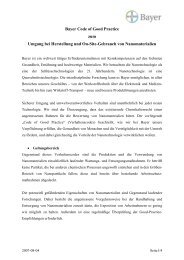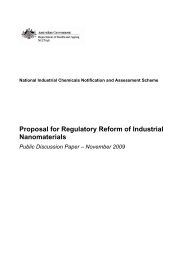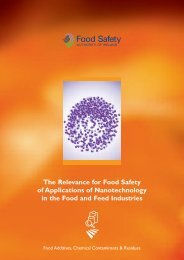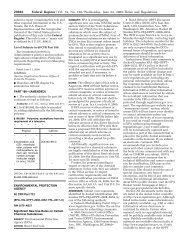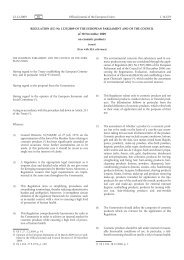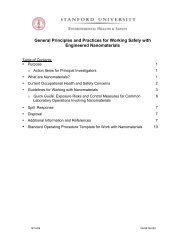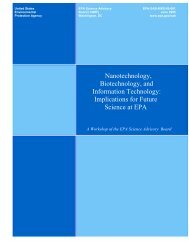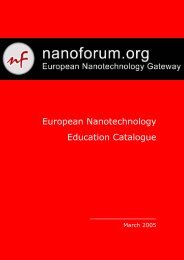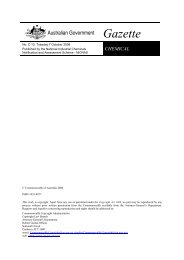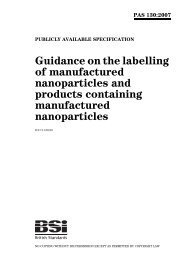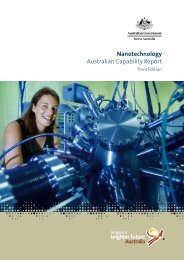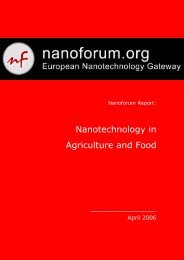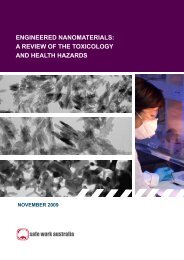Nanoforum - Nanotech Regulatory Document Archive
Nanoforum - Nanotech Regulatory Document Archive
Nanoforum - Nanotech Regulatory Document Archive
Create successful ePaper yourself
Turn your PDF publications into a flip-book with our unique Google optimized e-Paper software.
development programs, on improving the quality of life; information and communication<br />
technologies; environmental and materials research; research on agribusiness and<br />
biotechnology; and research on national heritage and contemporary social challenges.<br />
<strong>Nanotech</strong>nology, in particular manufacturing and analysis of materials on the molecular<br />
level, is part of program 3 on environmental and materials research. Program 2 on ICT<br />
includes application of molecular level information technologies. (Source: Research<br />
and Development, http://www. om.hu/english).<br />
There are three major sources of funding competitive R&D programmes. The aim of the<br />
National R&D Programmes (NRDPs) is to support research, development and<br />
innovation projects, focusing on interdisciplinary research. Special attention is given to<br />
large integrated projects implemented by consortia comprising the higher education<br />
sector, other public R&D institutions and industry. The National Scientific Research<br />
Fund (NSRF) was first established in 1986 to support scientific research, to establish<br />
conditions necessary for performing these activities and to publish results. Funding<br />
concentrates on thematic programmes with a special focus on young researchers, on<br />
scientific equipment and for post-doc support (for projects in Hungary only). The<br />
National Technology Development Fund (NTDF) supports technological innovation,<br />
the development of R&D infrastructure and the dissemination and economic application<br />
of research results.<br />
In connection with these objectives the government intends to bring the state and the<br />
business sectors closer to each other since they have a role in ensuring that research,<br />
development and production are closely intertwined and placed in the service of the<br />
country's economic advancement. To achieve this, an attempt has been made to<br />
establish co-ordinated education, research and innovation policies, as well as measures<br />
to stimulate R&D activities of the private sector.<br />
The Hungarian Science and Technology Foundation is a non-profit public foundation.<br />
The Ministry of Foreign Affairs of Hungary established the foundation in 1994. The<br />
Foundation's aims and activity areas are to support scientific and R&D activities by<br />
distributing funding to a variety of national and international co-operative research<br />
efforts. Www.tetalap.hu<br />
Hungarian R&D organisations have an increasing opportunity to participate in<br />
multilateral and bilateral scientific programmes. Recent decades have seen an increase<br />
in the opportunities available for international technology co-operation.<br />
Hungary is a member of most European and Euro-Atlantic research organisations and<br />
programmes (e.g. EU R&D Framework Programme, COST, EUREKA, CERN, EMBL,<br />
ESA/PRODEX and the NATO Science Programme). According to the Hungarian<br />
Central Statistical Office, about 10% of total GERD in Hungary came from abroad in<br />
2001. Most of this has come from the EC Framework Programme in which Hungary has<br />
participated as a full member. The Hungarian contribution to the Framework<br />
Programme has been about 5% of the total budget of the Ministry of Education (in most<br />
EU countries, contributions to the EC are paid by the Ministry of Finance). Until now the<br />
Hungarian contribution and total grant awarded by the EC is approximately the same.<br />
99



